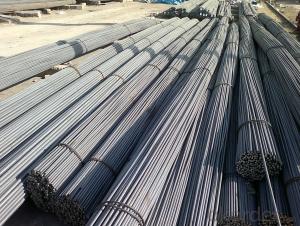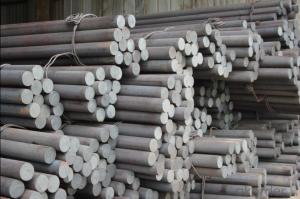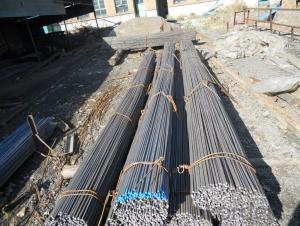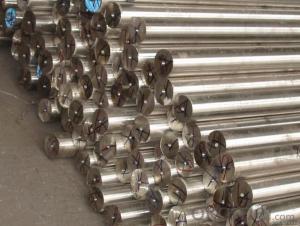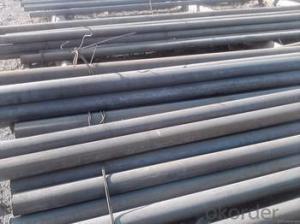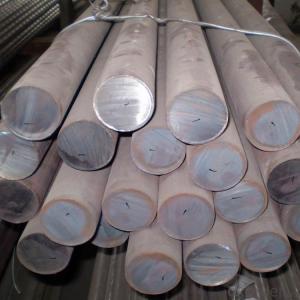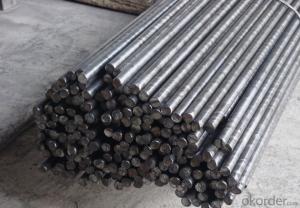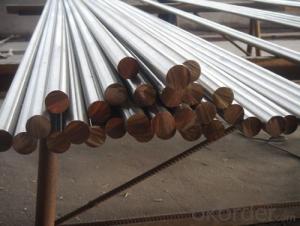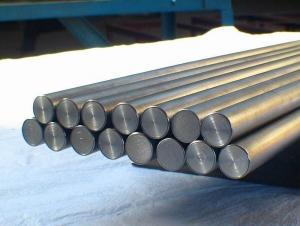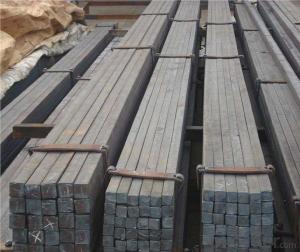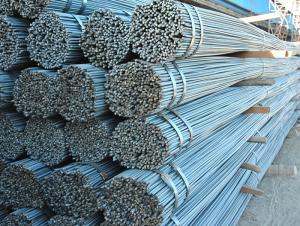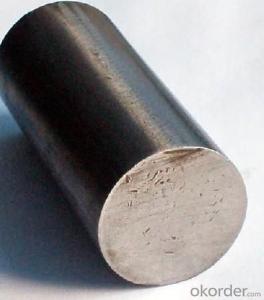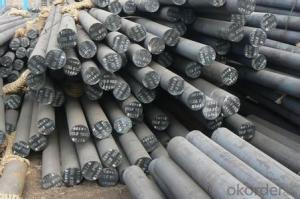Hot Rolled GB Standard Round Steel Bar Q235, SAE1020
- Loading Port:
- Shanghai
- Payment Terms:
- TT or LC
- Min Order Qty:
- 25 m.t.
- Supply Capability:
- 200000 m.t./month
OKorder Service Pledge
OKorder Financial Service
You Might Also Like
Product Description:
OKorder is offering Hot Rolled GB Standard Round Steel Bar Q235, SAE1020 at great prices with worldwide shipping. Our supplier is a world-class manufacturer of steel, with our products utilized the world over. OKorder annually supplies products to European, North American and Asian markets. We provide quotations within 24 hours of receiving an inquiry and guarantee competitive prices.
Product Applications:
Hot Rolled GB Standard Round Steel Bar Q235, SAE1020 are ideal for structural applications and are widely used in the construction of buildings and bridges, and the manufacturing, petrochemical, and transportation industries. Carbon steel round bar is the most common form of steel because its price is relatively low while it provides material properties that are acceptable for many applications, more so than iron. It is often used when large quantities of steel are needed, for example as structural steel. The density of this product is approximately 7.85g/cm³ and the young's modulus, like all steels.
Product Advantages:
OKorder's Hot Rolled GB Standard Round Steel Bar Q235, SAE1020 are durable, strong, and resist corrosion.
Main Product Features:
· Premium quality
· Prompt delivery & seaworthy packing (30 days after receiving deposit)
· Corrosion resistance
· Can be recycled and reused
· Mill test certification
· Professional Service
· Competitive pricing
Specifications of Hot Rolled GB Standard Round Steel Bar Q235, SAE1020
1. Grade: Q235, SS400, S235JR, A36
2. Sizes: Diameter: 6mm-150mm; Length: 6m, 9m, 12m or as customer’s request
3. Type: Mild steel; Low carbon steel
4. Shape: Round bar, solid bar of steel with circular section
5. Technique: Hot rolled or cold drawn
6. Mass: Mass(kg/m) = Diameter(mm)×Diameter(mm)×0.00617
Steel Type | Maximum forging temperature (°F / °C) | Burning temperature (°F / °C) |
1.5% carbon | 1920 / 1049 | 2080 / 1138 |
1.1% carbon | 1980 / 1082 | 2140 / 1171 |
0.9% carbon | 2050 / 1121 | 2230 / 1221 |
0.5% carbon | 2280 / 1249 | 2460 / 1349 |
0.2% carbon | 2410 / 1321 | 2680 / 1471 |
3.0% nickel steel | 2280 / 1249 | 2500 / 1371 |
3.0% nickel–chromium steel | 2280 / 1249 | 2500 / 1371 |
5.0% nickel (case-hardening) steel | 2320 / 1271 | 2640 / 1449 |
Packaging & Delivery of Hot Rolled GB Standard Round Steel Bar Q235, SAE1020
Packaging Detail: All goods are packed in bundle with steel strips and shipped by break bulk vessel or container (depend on target market and different ports)
Delivery Detail: 45 days
Trade terms: FOB, CFR, CIF
MOQ: 25 tons per specification; we can negotiate the quantity if the specification is normal or we have stock of one specification.
Weight: The price invoicing on theoretical weight basis or actual weight basis depends on customer’s request.
Shipment: The shipment of bulk break or container is depends on customer’s request and the situation of the port of destination.
Documents given: Full set of original clean on board bill of lading; Original signed commercial invoice; Original packing list; Policy of insurance; Certificate of origin and what the target market needs.
Production Flow of Hot Rolled GB Standard Round Steel Bar Q235, SAE1020
1. The common processes are preheated forging quenching, dual refinement solution process, cooling quenching and isothermal quenching. We use heat treatment for dual refinement solution process. The main measures process is high temperature solution and refinement cycle. High temperature solution can improve the carbide morphology and particle size. The aim is to make the loop refinement ultrafine austenite grains.
2. EAF+LF+VD+ Forged+ Heat Treatment

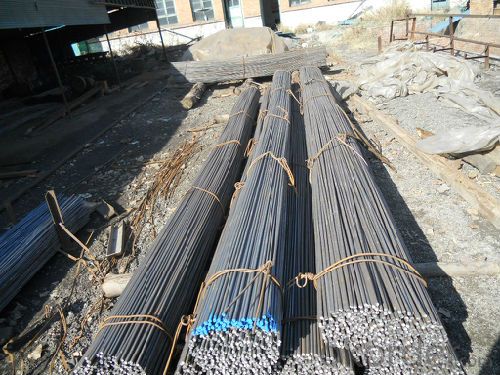
FAQ:
Q1: How soon can we receive the product after purchase?
A1: Within three days of placing an order, we will begin production. The specific shipping date is dependent upon international and government factors, but is typically 7 to 10 workdays.
Q2: How do we guarantee the quality of our products?
A2: We have established an advanced quality management system which conducts strict quality tests at every step, from raw materials to the final product. At the same time, we provide extensive follow-up service assurances as required.
Q3: Can fit in the containers of 20fts the steel beams of 6M?
A3: No proble, we can put them into the containers in the form sideling.
- Q: Can steel round bars be used in food processing applications?
- Using steel round bars in food processing applications is not advisable. These bars are usually crafted from carbon steel, which may contain impurities and fail to meet the required food safety standards. When working with food, it is crucial to utilize materials that are explicitly designed and sanctioned for food contact, like stainless steel. Stainless steel boasts superior resistance to corrosion, ease of cleaning, and non-reactivity with food, preserving its original flavor. Hence, to guarantee the safety and integrity of processed food, it is recommended to employ stainless steel round bars or other food-grade materials in food processing applications.
- Q: Can steel round bars be used in the manufacturing of conveyor systems?
- Yes, steel round bars can be used in the manufacturing of conveyor systems. Steel is a strong and durable material that can withstand heavy loads and provide stability and support to conveyor systems. Steel round bars can be used as rollers or shafts in conveyor systems to facilitate the movement of materials or products along the conveyor belt. The smooth surface of the round bars allows for easy rotation and reduces friction, ensuring the smooth operation of the conveyor system. Additionally, steel round bars can be easily customized to fit specific conveyor system requirements, making them versatile and suitable for various industrial applications.
- Q: What are the different types of steel round bars used in the automotive suspension systems?
- Automotive suspension systems utilize various types of steel round bars, each with its own distinct properties and benefits. 1. Carbon steel round bars, which are the most commonly employed in automotive suspension systems, offer excellent strength and durability. Their ability to withstand the weight and stress of vehicles make them an ideal choice. Additionally, carbon steel round bars boast exceptional machinability, allowing for easy customization and fabrication. 2. Alloy steel round bars are created by incorporating different alloying elements, such as chromium, nickel, or molybdenum, into carbon steel. This enhances their mechanical properties, resulting in increased strength, hardness, and wear resistance. These alloy steel round bars are frequently utilized in crucial suspension components like control arms or sway bars. 3. Stainless steel round bars are renowned for their resistance to corrosion and aesthetic appeal. Although not as prevalent in automotive suspension systems, they find application in specific scenarios where protection against rust or chemical exposure is necessary. Furthermore, stainless steel round bars offer considerable strength and high temperature resistance, making them suitable for specific suspension components. 4. High-strength steel round bars are explicitly designed to provide exceptional strength and toughness. These bars are commonly employed in demanding suspension applications, including heavy-duty trucks or performance vehicles, which require increased load-bearing capacity and enhanced resistance to fatigue. 5. Forged steel round bars are distinguished by their exceptional strength and structural integrity. They are formed by subjecting the steel to high temperatures and shaping it under immense pressure. This manufacturing process results in a dense and uniform structure, rendering forged steel round bars highly reliable and suitable for rigorous suspension systems. In conclusion, automotive suspension systems utilize several types of steel round bars, including carbon steel, alloy steel, stainless steel, high-strength steel, and forged steel. Each type possesses unique properties and advantages tailored to the specific requirements of various suspension components.
- Q: What are the different specifications for steel round bars?
- There are several specifications that are used to describe steel round bars. These specifications include the diameter, length, tolerance, and grade of the steel used. The diameter of a steel round bar is a key specification, as it determines the size of the bar. Common diameters range from 1/4 inch to 12 inches, with various increments in between. The diameter is usually measured across the widest point of the bar. The length of a steel round bar refers to its overall size from end to end. Standard lengths range from 10 to 20 feet, although custom lengths can also be obtained. The length is an important factor to consider when determining the quantity needed for a specific project. Tolerance is another specification that describes the allowable deviation from the specified diameter or length. It ensures that the steel round bar meets the required dimensions and can be used effectively. Tolerance values are typically expressed in plus or minus values, such as +/- 0.005 inches. The grade of steel used in round bars is also specified, indicating the quality and strength of the material. Common grades include carbon steel, alloy steel, stainless steel, and tool steel. Each grade has its own unique properties and is suitable for different applications based on the desired strength, corrosion resistance, and machinability. In addition to these specifications, other factors such as surface finish and heat treatment may also be specified depending on the intended use of the steel round bars. These specifications ensure that the steel meets the necessary requirements for a particular application, whether it be in construction, manufacturing, or other industries.
- Q: What is the difference between a hot-rolled and a peeled steel round bar?
- The main difference between a hot-rolled and a peeled steel round bar lies in their manufacturing processes. A hot-rolled steel round bar is formed by heating a metal billet or ingot to a high temperature and then rolling it into its final shape and size. This process results in a rougher surface texture and a larger diameter tolerance. On the other hand, a peeled steel round bar undergoes an additional step called peeling after the hot-rolling process. In this step, the outer surface of the bar is removed by rotating it against a stationary cutting tool. This process improves the surface finish and dimensional accuracy of the round bar, resulting in a smoother and more precise product. In summary, while both hot-rolled and peeled steel round bars are commonly used in various industries, the peeled bar offers superior surface finish and dimensional accuracy due to the additional peeling step in its manufacturing process.
- Q: What is the maximum length of a steel round bar?
- The length of a steel round bar can vary depending on several factors, including the bar's diameter, the manufacturing capabilities of the steel supplier, and transportation restrictions. Typically, steel round bars are made in standard lengths ranging from 6 to 12 meters (20 to 40 feet). However, it is possible to create longer bars through specialized processes or by combining multiple bars using welding techniques. In certain cases, it is possible to order custom-made steel round bars that exceed standard lengths, but this would necessitate making specific arrangements with the supplier and considering logistical and handling aspects during transportation. Ultimately, the maximum length of a steel round bar is determined by practical limitations and the specific requirements of the project or application.
- Q: What is the difference between a rough turned and a seamless steel round bar?
- A rough turned steel round bar refers to a metal bar that has undergone a preliminary turning process, where excess material is removed to achieve a rougher surface finish. This process helps to create a more uniform diameter and removes any surface imperfections or irregularities. Rough turned bars are commonly used in applications where a smooth surface finish is not a requirement, such as in manufacturing machinery or agricultural equipment. On the other hand, a seamless steel round bar is a solid metal bar that is formed without any welding or seams. It is manufactured through a process called piercing, where a solid billet is heated and then pierced with a mandrel to create a hollow tube. The tube is then elongated and reduced in diameter through a series of rolling and drawing processes until it reaches the desired dimensions. Seamless round bars are known for their superior strength and resistance to corrosion, making them suitable for applications where a high level of performance is required, such as in the oil and gas industry or automotive manufacturing. In summary, the main difference between a rough turned and a seamless steel round bar lies in their manufacturing processes and surface finishes. Rough turned bars are created by removing excess material to achieve a rougher surface finish, while seamless bars are formed without any welding or seams, resulting in a smooth and continuous surface.
- Q: Can steel round bars be used for making suspension springs?
- Certainly! Suspension springs can indeed be made using steel round bars. The reason steel is often chosen as the material for suspension springs is because of its exceptional strength and durability. By forging or shaping the round bars into the desired spring shape, and subsequently subjecting them to heat treatment, the desired spring characteristics can be achieved. Moreover, steel round bars can be effortlessly machined and drilled to accommodate various suspension systems and components. Nevertheless, it is crucial to carefully consider the specific requirements and load capacity of the suspension system, in order to ensure that the selected steel round bars are appropriate for the intended application.
- Q: What is the difference between hot rolled and cold rolled steel round bars?
- Hot rolled and cold rolled steel round bars differ in their production process and resulting characteristics. Hot rolled steel round bars are made by heating billets or ingots to a high temperature and then shaping them into the desired form using rolling mills. This process results in a scaled surface and a relatively rough texture. Hot rolled steel round bars have a wider tolerance and are not as precise in terms of their dimensions. They are generally used in applications where precision is not critical, such as construction and general manufacturing. On the other hand, cold rolled steel round bars are manufactured by cooling down hot rolled steel to room temperature and then further processing it through cold rolling mills. This process results in a smoother surface and a more precise dimension. Cold rolled steel round bars have a tighter tolerance and are commonly used in applications where precision is crucial, such as automotive components, machinery parts, and tools. In terms of mechanical properties, hot rolled steel round bars generally have a lower tensile strength and yield strength compared to cold rolled steel round bars. Cold rolled steel also tends to have a higher hardness and a more uniform grain structure, which can enhance its strength and durability. Overall, the main difference between hot rolled and cold rolled steel round bars lies in their production process, surface finish, dimensional accuracy, and mechanical properties. The choice between the two depends on the specific requirements of the application and the desired characteristics of the end product.
- Q: How do steel round bars perform under bending or flexing forces?
- Steel round bars generally perform well under bending or flexing forces due to their high tensile strength and ductility. When subjected to bending forces, the steel round bars can resist deformation and maintain their shape, making them suitable for various applications such as construction, manufacturing, and engineering. The combination of high strength and ductility allows the bars to absorb and distribute the applied load evenly, minimizing the risk of failure or breakage. The behavior of steel round bars under bending or flexing forces can be further enhanced by factors such as the alloy composition, heat treatment, and manufacturing process. Different grades of steel can offer varying levels of strength, toughness, and resistance to bending. Heat treatment processes like quenching and tempering can further improve the mechanical properties, making the bars more resistant to bending and flexing. However, it is important to note that excessive bending or flexing can lead to permanent deformation or failure of the steel round bars. Overloading or repeated bending beyond the material's limits can cause stress concentrations, microcracks, or even fractures. Therefore, it is crucial to determine the appropriate bending limits and ensure proper design and installation to maintain the structural integrity and safety of steel round bars under bending or flexing forces.
Send your message to us
Hot Rolled GB Standard Round Steel Bar Q235, SAE1020
- Loading Port:
- Shanghai
- Payment Terms:
- TT or LC
- Min Order Qty:
- 25 m.t.
- Supply Capability:
- 200000 m.t./month
OKorder Service Pledge
OKorder Financial Service
Similar products
Hot products
Hot Searches
Related keywords
